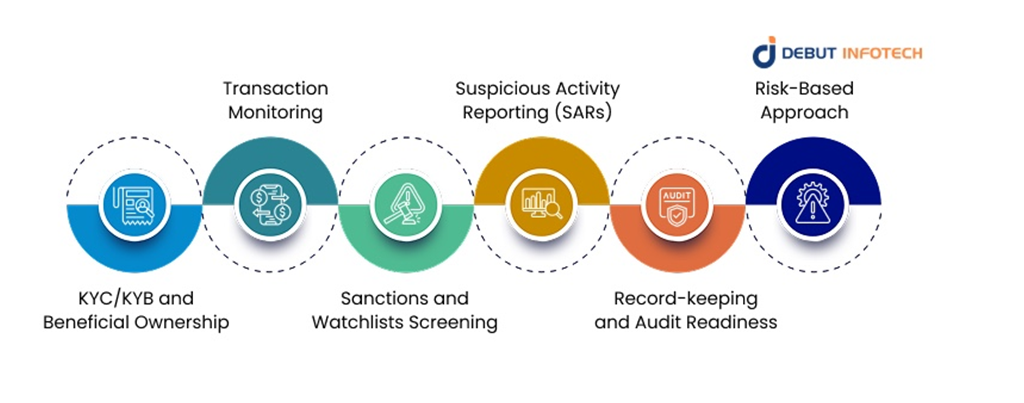CRYPTO
The Smart Executive’s Guide to AML Crypto Exchange Compliance and Risk Management

Quick question: what do you reckon is the trickiest part of running a crypto exchange?
Delivering a quality user experience? Maintaining liquidity? Or keeping crypto listings up-to-date?
These are all worthy mentions; however, staying on the right side of the regulatory frameworks is right at the top of that list.
You see, in recent times, anti-money Laundering (AML) has become the make-or-break factor for survival. Fail here, and you risk fines, lawsuits, and lost banking partners. Succeed, and you earn trust, legitimacy, and growth.
So, how do you navigate this tricky landscape as a smart executive?
In this guide, we’ll break down:
- What AML really means for crypto exchanges
- The global regulatory landscape
- Core AML requirements
- How to build a smart AML framework
- And how to manage risk effectively
Let’s dive in.
What is Anti-Money Laundering (AML)?
Anti-Money Laundering (AML) refers to a set of legally recognized rules, processes, and technologies that are designed specifically to detect and prevent the transformation of fraudulent funds into legitimate income.
In a nutshell, it is all the processes that are set up to make sure that users don’t launder money through all these day-to-day operations, especially in a crypto exchange. These processes also help to limit the possibilities of other financial crimes, such as identity theft and tax evasion.
So, what do these “processes” entail? Some of these include:
- Monitoring customer transactions for suspicious activity
- Reporting transactions in a timely manner
- Verifying customer identities
- Executing customer due diligence
Wondering why all these things are necessary?
Because cryptocurrencies move fast, across borders, and often without intermediaries like banks. They’re especially common in models such as a decentralized crypto exchange, where users trade peer-to-peer without a central authority. That makes them attractive not only to innovators but also to bad actors. Regulators know this, which is why every AML-compliant exchange today must have robust safeguards in place.
And here’s where the importance of KYC and AML for crypto exchanges really comes into play. KYC (Know Your Customer) makes sure you know who’s on your platform. AML makes sure you know what they’re doing. Together, they’re the foundation for staying compliant, keeping regulators satisfied, and, frankly, keeping your business alive.
The Global AML Landscape Every Crypto Exchange Must Understand
One thing you need to know about the current AML landscape is that regulatory landscapes are not leaving the implementation of these rules and processes to chance. If you want to operate an AML approved crypto exchange, you’ll need to understand not only your home country’s rules but also how global frameworks overlap.
So, what are these global frameworks?
The most notable ones include:
- Financial Action Task Force (FATF): The Financial Action Task Force (FATF) is the global watchdog for combating money laundering and terrorist financing. As such, the institution issues AML guidelines such as the popular ‘Travel Rule’, which mandates that exchanges must share information regarding the sender and recipient of cryptocurrency transactions for transparency.
- The Markets in Crypto-Assets Regulation (MiCA): MiCA is a European Union framework that defines crypto-assets, how they are regulated, who can regulate them, requirements for any non-fungible token, and provides crypto products and services.
- Financial Crimes Enforcement Network (FinCEN): FinCEN is the organization responsible for devising laws that financial institutions must comply with to prevent money laundering, including identity verification and regulatory reporting in the US.
Other regulatory bodies you should look out for include the SEC, CFTC, and the upcoming AMLR. As such, the existence of these different AML-focused regulatory bodies means crypto exchanges like yours must run a thorough crypto exchange AML check before launching in a new market.
Core AML Requirements For Crypto Exchanges
 So, let’s say we want to start aligning with these crypto exchange AML regulatory frameworks. What are some key requirements that crypto exchanges like yours should consider?
So, let’s say we want to start aligning with these crypto exchange AML regulatory frameworks. What are some key requirements that crypto exchanges like yours should consider?
The following are some of the most vital ones:
1. KYC/KYB and Beneficial Ownership
KYC stands for Know Your Customer, while KYB means Know Your Business. Both these terms represent the standard processes for ensuring your crypto exchange verifies the identities behind every account and actually discovers who’s in control of the account.
With that insight, it becomes relatively easier to stop shell companies or anonymous wallets from manipulating funds without being detected. This functionality marks the vital importance of KYC and AML for crypto exchanges as regulators now expect a high level of discipline.
2. Transaction Monitoring
Once you have onboarded users onto your crypto exchange platform (with KYC/KYB checks), you need to start monitoring their activity on the platform.
This involves tracking all transactions, including deposits, withdrawals, and suspicious transfers. It’s relatively easier to keep up with all these if you use designated flagging lists and regulatory body-approved alert triggers to stay on top of all rising situations.
3. Sanctions and Watchlists Screening
Furthermore, you must implement systems that automatically screen users actively against international lists such as the UN Sanctions List, the EU Consolidated List, and OFAC (US). It is important for every AML crypto exchange to do this to ensure that they can pick up on flagged users before they start executing any transactions on your platform. Ignoring a sanctioned entity is a nightmare for your reputation in addition to being a compliance failure.
4. Suspicious Activity Reporting (SARs)
In the event that any unusual money laundering activity were to happen on your crypto exchange, it is essential to be able to document it and report it to the appropriate regulatory authority in record time.
Regulators expect to know if anything seems amiss. Therefore, SARs must be completed on time, in detail, and with documentation. Too many transactions have been penalized for improperly reporting harmful actors rather than for failing to identify them.
5. Record-keeping and Audit Readiness
While reporting these suspicious activities, it is vital to maintain a traceable paper trail between your crypto exchange and the regulatory body. Doing this ensures that the appropriate bodies have enough evidence and hard facts to follow up on the auditing process.
So, what does record-keeping and audit readiness entail? It generally involves keeping customer onboarding, transaction, and internal investigation records for a number of years, usually five to ten. You will need to demonstrate that everything can be traced when auditors arrive.
6. Risk-Based Approach
No matter how careful you might try to be, the truth is that not all transactions or users are equally risky. As a result, regulators anticipate that you will give higher-risk cases, such as those involving politically exposed individuals, cross-border flows, or trades conducted on a p2p crypto exchange, more attention. This is where a robust crypto exchange AML check framework becomes essential. This check allows you to manage the risks associated with each situation accordingly, minimizing the margins for error.
How to Build a Smart AML Framework for Maintaining AML Exchange Compliance and Risk Management
Now, we know what is required for the modern-day AML crypto exchange.
But how can executives actually put this into practice?
Implementing these vital actions can help you develop an AML approved crypto exchange in no time:
1. Prioritize Governance and Accountability
Every serious AML crypto exchange starts with clear leadership. You should do the same by appointing a dedicated compliance officer who maintains board oversight. This signals to investors that the exchange is serious about taking responsibility.
2. Implement Robust Policies and Internal Controls
Apart from having clear leadership that maintains general oversight, it is also important to have robust policies and internal controls baked into daily operations. In practice, this means having standard onboarding workflows for flagging high-risk users, having clear escalation paths for suspicious activities, and creating truly functional internal reporting lines.
3. Leverage Technology and Automation
Implementing and maintaining regular checks to ensure alignment with these new AML regulations can be quite demanding. That’s why smart exchanges employ automated monitoring systems that operate around the clock, machine learning to identify anomalous activity patterns, and blockchain analytics tools to track wallets. These solutions reduce false positives and satisfy regulators by streamlining the crypto exchange AML verification procedure.
4. Incorporate Staff Training and Culture
A framework is only as strong as the people using it. Everyone, from customer support to compliance staff, requires regular training on identifying red flags, reporting protocols, and regulatory updates. Building a compliance-first culture reduces human error and keeps your exchange credible.
5. Maintain Strategic Partnerships
Want access to banking rails, payment processors, or institutional investors? Then you need a reputation for compliance. Banks in particular will only work with an AML approved crypto exchange — so view AML as your ticket to these partnerships, not just a legal burden.
Conclusion
There you have it: if you’re looking to launch a crypto exchange capable of building trust, securing partnerships, and scaling globally, then you have to take AML seriously. Whether you’re exploring a decentralized crypto exchange, planning a p2p crypto exchange development, or considering a white label crypto exchange to speed your launch, compliance must be built in from day one.
From OTC crypto exchange development to decentralized exchanges, we at Debut Infotech specialize in crypto exchange development, helping enterprises develop secure, scalable, and fully compliant platforms.
We believe that AML compliance can become a competitive advantage when paired with the proper partner. Let’s prove it to you today.
Get in touch.

CRYPTO
5starsstocks.com income stocks: Exploring Income Stock Opportunities

Are you looking for reliable ways to grow your wealth while enjoying a steady stream of income? If so, the world of income stocks might just hold the key. With an ever-changing financial landscape, investors are increasingly turning to dividends as a source of consistent returns. Among various platforms that offer insights on stock investments, 5starsstocks.com stands out with its comprehensive analysis and timely recommendations.
Imagine earning money simply by owning shares in well-established companies! Income stocks provide not only potential capital appreciation but also regular payouts that can enhance your cash flow. Whether you’re saving for retirement or seeking passive income streams, delving into 5starsstocks.com income stocks could be a game changer. Let’s explore this investment opportunity further and discover why it deserves a spot in your portfolio.
What is 5starsstocks.com income stocks?
5starsstocks.com income stocks are investment options focused on generating regular cash flow for investors. These stocks typically belong to well-established companies that prioritize returning profits to shareholders through dividends.
Investors often seek out these types of stocks as a reliable source of income, especially during retirement or when looking to diversify their portfolios. The platform serves as a resource for identifying and analyzing such opportunities.
What sets 5starsstocks.com apart is its in-depth research and stock analysis tailored specifically for those interested in building an income-generating portfolio. This makes it easier for both novice and experienced investors to make informed decisions.
By offering insights into dividend yields, payout ratios, and historical performance, the site helps users navigate the sometimes complex world of income investing with confidence.
Why Should You Consider Income Stocks?
Income stocks offer a unique opportunity for investors looking to generate steady cash flow. Unlike growth stocks, which aim for capital appreciation, income stocks focus on delivering consistent dividend payments.
These dividends can provide a reliable source of income, making them especially appealing during market volatility. Investors can benefit from regular payouts while still holding onto their shares.
Moreover, many income stocks come from established companies with stable earnings. This stability often translates into lower risk compared to more speculative investments.
The compounding effect of reinvesting these dividends can also bolster your overall returns over time. It’s an attractive strategy for those seeking long-term wealth accumulation alongside immediate financial benefits.
In addition, investing in income stocks allows you to diversify your portfolio effectively. Income-generating assets balance out the risks associated with other investment types and help protect against downturns in the market.
Top 5 Income Stock Picks from 5starsstocks.com
When exploring income stocks, 5starsstocks.com offers some compelling options. These picks stand out for their consistent dividends and growth potential.
First up is Company A, known for its reliable payout history. Investors appreciate its strong market position and steady revenue streams.
Next is Company B, which has a reputation for significant dividend increases over the years. Its commitment to shareholders makes it a favorite among income-focused investors.
Company C combines solid financials with an attractive yield. This stock appeals to those looking for stability in uncertain markets.
Don’t overlook Company D either; it boasts impressive cash flow metrics that support ongoing dividends while expanding its operations strategically.
There’s Company E–a hidden gem that’s been steadily gaining traction in recent months. With a focus on innovation, it’s poised to offer both growth and income potential moving forward.
How to Evaluate and Choose the Right Income Stocks
When evaluating income stocks, focus on dividend yield first. A higher yield can indicate a more attractive investment, but it should be sustainable.
Next, analyze the company’s payout ratio. This ratio reveals how much of its earnings are distributed as dividends. Ideally, you want a balance that allows for growth while providing solid returns.
Examine the company’s financial health too. Look at key metrics such as revenue growth and profit margins. Strong fundamentals often lead to reliable dividend payments.
Don’t overlook industry stability either. Some sectors are more susceptible to economic downturns than others. This could impact dividend sustainability.
Consider historical performance trends in dividends paid over time. Consistent or increasing payouts signal a commitment to returning value to shareholders and can help inform your decision-making process.
Risks and Benefits of Investing in Income Stocks
Investing in income stocks can offer a reliable stream of revenue. Dividends provide investors with regular cash flow, making it appealing for those seeking financial stability.
However, there are risks to consider. Market volatility can impact stock prices and dividends might be cut if a company faces challenges. Always assess the company’s financial health before committing.
Another benefit is diversification. Income stocks often belong to established companies with proven track records. This stability can mitigate some investment risk when included in a broader portfolio.
On the flip side, over-reliance on income stocks may limit growth potential. These companies typically reinvest less into their operations compared to growth-focused firms.
Understanding both sides enables well-informed decisions tailored to individual investment strategies and risk tolerance levels.
Tips for Managing a Diversified Income Stock Portfolio
Diversifying your income stock portfolio is crucial for minimizing risk. Start by investing in various sectors, like utilities, real estate, and consumer goods. This approach helps balance performance during market fluctuations.
Regularly review your holdings to ensure they align with your financial goals. Look for stocks that provide consistent dividends along with potential growth.
Consider the geographic diversity of your investments too. Stocks from different regions can offer protection against local economic downturns.
Reinvesting dividends can also enhance returns over time. Compounding works wonders when you allow those earnings to grow rather than withdrawing them immediately.
Keep an eye on market trends and shifts in interest rates. Adapting your strategy based on these factors will keep your portfolio dynamic and resilient.
Conclusion
Investing in income stocks offers a unique opportunity to generate steady cash flow while participating in the stock market. With resources like 5starsstocks.com income stocks, you can find valuable insights and stock picks that align with your investment goals. Income stocks are not just for retirees; they appeal to anyone seeking regular financial returns.
Understanding how to evaluate these investments is crucial. Factors such as dividend yield, company stability, and growth potential should guide your decisions. It’s also essential to be aware of the risks involved—market fluctuations can impact dividends, and some sectors may perform better than others over time.
Diversification remains key when managing an income stock portfolio. Spreading investments across various sectors helps mitigate risk while maximizing opportunities for returns.
By leveraging platforms like 5starsstocks.com and employing strategic evaluation methods, investors can navigate this segment effectively. The journey into income stocks could lead you toward financial stability and growth if approached thoughtfully.
CRYPTO
crypto30x.com zeus: Revolutionizing Crypto Trading Strategies

In the fast-paced world of cryptocurrency, staying ahead of the game is crucial. As digital currencies continue to reshape financial landscapes, traders are on a constant quest for innovative strategies that can maximize profits and minimize risks. Enter crypto30x.com zeus—a platform designed to revolutionize the way we approach crypto trading.
With an intuitive interface and cutting-edge technology, Zeus promises not just efficiency but also a transformative experience for both seasoned traders and newcomers alike. It’s time to explore how this powerful tool is setting new standards in the crypto market and empowering users to harness their trading potential like never before. Buckle up as we dive deep into what makes crypto30x.com zeus a game-changer in the realm of cryptocurrency!
What is crypto30x.com zeus?
Crypto30x.com Zeus is a cutting-edge platform designed to enhance crypto trading strategies for both novice and seasoned traders.
At its core, Zeus leverages advanced algorithms and data analytics to provide real-time insights into market trends. This empowers users with the knowledge needed to make informed decisions swiftly.
The platform stands out due to its user-friendly interface, making it accessible even for those new to cryptocurrency trading.
With features that cater specifically to individual trading styles, Crypto30x.com Zeus adjusts strategies based on personal preferences and risk tolerance.
Security is paramount; the site employs robust measures ensuring that user information and funds are well-protected against cyber threats.
By integrating education tools alongside practical applications, Zeus helps traders grow their skills while engaging in live markets.
The Rise of Zeus: A Brief History
Zeus emerged in the crypto trading arena during a period of intense market volatility. Founded by a team of industry pioneers, this platform aimed to simplify and enhance trading strategies for both novices and seasoned traders.
Initially launched as a response to the challenges faced by crypto enthusiasts, Zeus quickly gained traction. Users were drawn to its innovative approach that combined advanced analytics with user-friendly features. This unique blend set it apart from existing platforms.
As adoption increased, so did its capabilities. Frequent updates and enhancements reflected real-time market needs. The community’s feedback played a crucial role in shaping Zeus into what it is today—a powerhouse of strategic insights designed specifically for cryptocurrency traders looking for an edge in their ventures.
How Zeus is Changing the Game
Zeus is reshaping how traders approach the crypto market. Traditional strategies often rely on outdated methods and slow reactions to trends. Zeus introduces a dynamic, algorithm-driven platform that adapts in real-time.
This innovative system harnesses advanced analytics and machine learning. Traders can now access insights that were previously difficult to obtain. The speed of execution ensures opportunities are seized before they vanish.
Moreover, Zeus democratizes trading for everyone, from beginners to seasoned pros. Its intuitive interface makes complex trading strategies accessible without overwhelming users.
The ability to customize settings allows individuals to tailor their experience according to risk tolerance and goals. This flexibility is crucial in an ever-changing digital landscape where every second counts.
By leveraging cutting-edge technology, Zeus empowers traders with tools that enhance decision-making while minimizing potential losses—a true game changer in the volatile world of cryptocurrency trading.
Key Features of crypto30x.com zeus
Crypto30x.com Zeus boasts several standout features that cater to both novice and experienced traders. Its intuitive interface makes navigation a breeze, allowing users to focus on strategy rather than technical hurdles.
One of the platform’s highlights is its advanced algorithmic trading system. This feature analyzes market data in real-time, identifying profitable opportunities almost instantaneously. Users can set their preferences for risk levels and receive automated alerts based on their chosen parameters.
Moreover, crypto30x.com Zeus offers comprehensive educational resources. From webinars to tutorials, traders have access to knowledge that enhances their decision-making skills.
Security is paramount here too. The platform employs state-of-the-art encryption protocols, ensuring user funds and data remain safe from potential threats.
The community aspect cannot be overlooked. Active forums allow users to share strategies and insights while building a supportive network within the crypto space.
User Testimonials and Success Stories
Users of crypto30x.com zeus have shared a myriad of success stories that highlight the platform’s potential. One trader, Sarah, started with minimal knowledge and found herself doubling her investments within weeks. The intuitive interface made learning easy for her.
Another user, Mark, had been skeptical about crypto trading until he tried Zeus. He appreciated how the automated strategies helped him make informed decisions without constant monitoring. His confidence grew as his portfolio expanded.
A growing community has formed around these experiences, fostering discussions on tips and strategies. Many users are eager to share their journeys from novice traders to confident investors using Zeus.
These testimonials showcase a blend of excitement and empowerment among users who have seen real results through this innovative platform. Each story reflects a unique path to financial growth in the ever-evolving world of cryptocurrency trading.
Comparison with Other Crypto Trading Platforms
When examining crypto30x.com zeus alongside other trading platforms, several distinctions become evident. While many platforms offer basic buy-and-sell functionalities, Zeus elevates the experience with advanced algorithms designed for precision and efficiency.
Traditional exchanges often lack automation, forcing users to manually track market trends. In contrast, Zeus employs sophisticated AI tools that assist traders in making informed decisions quickly.
Another notable comparison lies in user interface design. Many platforms overwhelm users with complex layouts and unnecessary information. Zeus opts for a streamlined approach that enhances usability, allowing both beginners and experts to navigate effortlessly.
Security is another crucial factor where Zeus stands out. While some competitors have faced significant breaches, crypto30x.com prioritizes user protection through state-of-the-art encryption techniques and multi-factor authentication measures. This commitment fosters trust among its growing community of traders.
Fees also play a pivotal role in decision-making for many traders. Compared to others offering hidden charges or steep withdrawal fees, Zeus maintains transparency by providing clear pricing structures without unexpected surprises.
Future of Crypto Trading with Zeus
The future of crypto trading is set to be transformed by Zeus. As technology continues to evolve, so do the strategies traders employ. Zeus stands at the forefront, promising smarter and more efficient ways to navigate the volatile landscape.
With advanced algorithms and real-time data analysis, users can make informed decisions quickly. This agility could mean higher profits in shorter time frames.
Moreover, as community engagement grows within the platform, user-generated insights will shape trading tactics. The power of collective intelligence cannot be underestimated.
Additionally, ongoing updates ensure that Zeus adapts to market fluctuations seamlessly. Traders can stay ahead with tools designed for both novices and experts alike.
As cryptocurrency becomes increasingly mainstream, platforms like crypto30x.com zeus will play a pivotal role in defining how individuals approach investments in digital assets.
Conclusion
As the cryptocurrency market continues to evolve, innovative tools and platforms like crypto30x.com zeus play a crucial role in shaping trading strategies. With its advanced features and user-centric design, Zeus is not just a tool but a game changer for traders at all levels. The platform’s unique approach to crypto trading, combined with real-time analytics and automated strategies, empowers users to make informed decisions.
The positive feedback from users highlights its effectiveness in navigating the complexities of the market. As more traders seek reliable solutions that enhance their experience, platforms like Zeus are set to become essential resources in this dynamic field.
Looking ahead, it’s clear that crypto30x.com zeus is positioned to lead the charge into a new era of digital asset management. Whether you’re an experienced trader or just starting out, embracing such innovations will undoubtedly be key to thriving amid rapid changes in cryptocurrency trading landscapes.
CRYPTO
Tarkov Bitcoin Explained: Why Virtual Gold Rules the Market

Escape from Tarkov is more than just a game; it’s an immersive survival experience that keeps players on the edge of their seats. Within its gritty world, players navigate through intense firefights and dangerous encounters, all while scavenging for resources to survive. Among these resources lies a coveted digital currency: Tarkov Bitcoin. This virtual asset has become a key player in the game’s economy, leading many to wonder how it works and why it holds such value.
Whether you’re a seasoned trader or new to the concept, understanding Tarkov Bitcoin can elevate your gameplay. From its historical significance in-game to potential investment strategies, this guide will dive deep into what makes Tarkov Bitcoin so essential for both survivalists and traders alike. Buckle up as we explore how this virtual gold rules the market!
What is Tarkov and the role of Bitcoin in the game
Escape from Tarkov is a hardcore, first-person shooter that blends elements of RPG and survival. Set in a fictional Russian city, players find themselves amidst an intense conflict between private military companies. The primary goal? Survive while looting gear, completing quests, and battling other players.
In this rugged landscape, Bitcoin plays a unique role as one of the most valuable currencies within the game’s economy. Unlike traditional loot items, Tarkov Bitcoin represents both wealth and status among traders.
Players can mine Bitcoin through the Hideout feature or acquire it on the Flea Market. This digital currency opens up new trading opportunities for essential supplies or rare items that can enhance gameplay further. As you engage with others in this treacherous world, possessing Tarkov Bitcoin offers significant advantages—making it a sought-after asset for many survivors navigating these uncertain times.
The History of Bitcoin in Tarkov
Bitcoin made its debut in Escape from Tarkov during the game’s ongoing development. Initially, it was a novel addition to the virtual economy, capturing players’ interest with its real-world parallels.
As gamers delved deeper into Tarkov’s gritty world, Bitcoin evolved beyond mere currency. It became a symbol of wealth and strategy within the gameplay. Players quickly learned that securing this digital asset could provide significant advantages.
The introduction of mining mechanics added another layer to the experience. Players could invest resources into generating Bitcoin through their Hideout, making it a crucial part of their survival tactics.
Over time, Bitcoin’s value fluctuated greatly based on player demand and market trends within Tarkov itself. This unpredictability mirrored real-life cryptocurrency dynamics and kept players engaged in economic strategies while navigating raids and battles.
How to Obtain and Use Bitcoin in Tarkov
Obtaining Tarkov Bitcoin can be a thrilling challenge. Players can find it as loot in various locations, typically inside high-value containers or during raids. Keep your eyes peeled for hidden caches and locked rooms where valuable items might be stashed.
Another method to acquire Bitcoin is through the Flea Market. If you have some spare currency or items, trading them for Bitcoin could bolster your stash quickly. Remember, market prices fluctuate based on supply and demand dynamics.
Using Bitcoin effectively involves smart decisions regarding its storage and trade potential. You can place it into your secure container for safety while planning future trades or investments within the game’s economy.
Additionally, consider utilizing the Bitcoin farm feature once you’ve progressed far enough in the game. It allows players to generate their own Bitcoins over time, benefiting from passive income while focusing on other aspects of gameplay.
Advantages of Using Bitcoin in Tarkov
Using Tarkov Bitcoin can significantly enhance your gaming experience. First, it serves as a stable currency in the ever-changing economy of Escape from Tarkov. Unlike regular items, Bitcoin retains its value, making it a reliable asset.
Moreover, players can generate passive income through their Bitcoin farms. This allows you to focus more on gameplay rather than grinding for every rouble needed to purchase gear.
Trading with other players is another advantage. Bitcoin’s universal appeal means many traders are willing to engage in deals using this cryptocurrency.
Additionally, holding onto Bitcoins offers liquidity during raids and trades. You can quickly convert them into cash or valuable goods when necessary.
Investing in Tarkov Bitcoin adds an engaging layer of strategy that keeps seasoned players coming back for more fun and profit potential within the game’s ecosystem.
Tips for Investing and Trading Bitcoin in Tarkov
When investing in Tarkov Bitcoin, timing is everything. Keep an eye on market trends and player demand. Prices fluctuate based on supply and events within the game.
Diversification can be a wise strategy. Don’t put all your resources into one asset. Explore other valuable items that may complement your Bitcoin investments.
Consider using the flea market for trading. This platform allows you to buy low and sell high, maximizing profits from strategic trades.
Always stay informed about updates or patches released by developers. Changes can impact Bitcoin’s value significantly.
Engage with the community to gather insights on upcoming trends or shifts in player behavior. Forums, Discord servers, and social media groups are excellent sources of information.
Practice patience when holding onto your assets. The virtual economy can swing dramatically; resist the urge to panic sell during downturns.
The Impact of Bitcoin on the In-Game Economy
Bitcoin has revolutionized the in-game economy of Tarkov. Its introduction brought a new layer of complexity to trading and resource management.
As players hoard Bitcoin, it creates scarcity among other items. This can drive prices up, impacting what traders are willing to pay for essential gear. The demand for Bitcoin often fluctuates, mirroring real-world market trends.
With its decentralized nature, players find themselves engaged in a more dynamic economic environment. Players must adapt their strategies based on current market conditions.
Additionally, Bitcoin serves as a status symbol within Tarkov. Owning substantial amounts can elevate a player’s reputation and standing among peers.
The presence of BTC also encourages strategic investments rather than impulsive spending. Players become more mindful of how they allocate their resources while navigating this virtual marketplace.
Future Predictions for Bitcoin in Tarkov
As Tarkov continues to evolve, Bitcoin’s role is likely to expand. Developers are known for introducing new mechanics and features that keep the game fresh. This could mean more ways to earn or utilize Bitcoin.
Player demand might lead to enhanced trading options. Imagine a marketplace where players can exchange items for Bitcoin directly, creating a vibrant economy within the game.
Additionally, we may see changes in how mining works. Current methods could be refined or replaced, offering players new strategies for obtaining this digital currency.
With growing interest in cryptocurrencies globally, Tarkov’s community may influence real-world trends too. Gamers often turn virtual currencies into serious investments outside of the game world.
As updates roll out and player behaviors shift, Bitcoin’s value in Tarkov will likely remain dynamic and unpredictable. Adaptability will be key for anyone looking to thrive financially within Escape from Tarkov.
Conclusion
Tarkov Bitcoin has become a pivotal component in the game, offering players unique opportunities and challenges. As one of the most valuable currencies within Escape from Tarkov, it not only influences gameplay but also shapes strategies for investing and trading.
The history of Bitcoin in Tarkov reflects its rise as a sought-after resource. Initially introduced to add depth to the economy, it quickly gained traction among players seeking an edge over their competitors. Understanding how to obtain and effectively use Bitcoin can elevate your gaming experience significantly.
For those looking to delve deeper into this virtual currency, there are numerous advantages associated with using Bitcoin in Tarkov. From acquiring rare items to ensuring your wealth remains protected during raids, mastering its use is essential for serious gamers.
Investing and trading tactics play a crucial role in maximizing your profits through Tarkov Bitcoin. With careful planning and market awareness, players can turn their investments into substantial gains.
Bitcoin’s impact on the overall economy of Tarkov cannot be understated. It affects everything from item prices to player interactions, creating a dynamic environment that requires constant adaptation.
As we look ahead, predictions about the future of Bitcoin within Escape from Tarkov suggest exciting possibilities. Players must stay informed about trends and shifts in value to maintain their competitive edge.
Understanding these facets will help you navigate both the digital landscape of Tarkov and enhance your overall gaming strategy effectively.
-

 TOPIC2 months ago
TOPIC2 months agov4holt: Revolutionizing Digital Accessibility
-

 TOPIC4 months ago
TOPIC4 months agoMolex 39850-0500: An In-Depth Overview of a Key Connector Component
-

 TOPIC2 months ago
TOPIC2 months agoMamuka Chinnavadu: An Exploration of Its Significance and Cultural Impact
-

 TOPIC3 months ago
TOPIC3 months agoGessolini: Minimalist Aesthetic Rooted in Texture
-

 TOPIC4 months ago
TOPIC4 months agoDorothy Miles: Deaf Poet Who Shaped Sign Language
-

 TOPIC4 months ago
TOPIC4 months agoManguonmienphi: Understanding the Concept and Its Impact
-

 TOPIC4 months ago
TOPIC4 months agoArnav Deepaware: A Rising Computer Scientist and Innovator
-

 blog3 months ago
blog3 months agoBlack Sea Body Oil: A New Standard in Natural Skincare